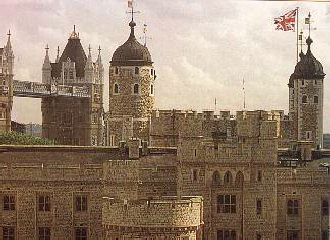 |
 |

The Tower of London
[Wednesday - 05/12/99] It all started because William or Normandy became outraged when his cousin, England's King Edward backed down on his promise to give the throne to William and ended up giving the throne to his English brother-in-law, Harold. William sailed his army across the English Channel and on October 14, 1066, he met Harold at Hastings and opened a can of whoop-ass on him. On Christmas Day later that year, William - now called William the Conqueror - was crowned King of England. He immediately fortified a variety of positions throughout England including one which stood in the southeastern corner of London, near an old Roman wall on the north bank of the Thames River. William ordered that this fort be removed in 1078 to be replaced by a huge stone stronghold. This would be the symbol of his power, a fortress for his defense, and a prison for his enemies. He named it the Tower of London.
Finished twenty years later, the Tower rises nearly one hundred feet high, with its walls fifteen feet thick in certain places. Inside is a chapel, apartments, guardrooms, and crypts which have been marvelously restored.
Around the year 1240, King Henry III made the tower his residence. White-washing the tower, widening the grounds to include a church, a great hall, and other buildings, Henry renamed the entire area the Tower of London, and christened his home the White Tower.
When Edward IV died, his brother Richard, the Duke of Gloucester, had the thirteen-year-old Edward V and his younger brother, the Duke of York, taken to the Tower. Lord Hastings, a royal officer, tried to protect Edward but failed, was beheaded and Edward and his brother were murdered. These murders most likely took place in the Garden Tower, which was later renamed the Bloody Tower. After killing Richard III in battle, King Henry VII moved into the Tower in 1485 and created a personal guard called the Yeoman Warders, who guard the Tower to this day. He was the last English monarch to have the Tower as his royal residence though many others still used it as both dungeon and a place for ceremony.
The marriage of King Henry VIII to his second wife, Anne Boleyn, took place at the Tower on May 19, 1533. On May 19, 1536, Anne Boleyn was executed under Henry's orders at the Tower Green. After Henry's death, their daughter Elizabeth was held prisoner in the Tower for two months by the order of her half sister, Queen Mary. On May 19, 1554, Elizabeth was released and in 1558, became the Queen of England. Spending three days preparing for her Coronation in the Tower, to symbolize that it was her duty to "take possesion" of it as the royal monarch of England, and on January 15, 1559, left in a festive parade to be crowned at Westminster Abby. She would never return to the Tower.
In 1603, part of the Tower of London became a museum. King James I had ordered that the Crown Jewels be kept in the Tower Jewel House and be put on display for the Tower visitors. Still used to hold prisoners up through World War II, the Tower has been the site of murders, marriages, rebellions, museums, and zoos. The Royal Armour Museum was here for decades until being recently moved to Leeds. But restorations continue to enhance this most famous of English landmarks and the new Medieval Palace is wonderful! I had to leave to meet some of my London friends for lunch but Lady Medb, Mistress Susan, and Lady Sine remained to explore and ogle the ravens!
|
Last modified on Wednesday, November 26, 2008 URL: http://www.housecorvus.org/tol.htm Copyright © 1999, 2000-09 House Corvus. All rights reserved. Design and hosting by Bran Trefonnen. | |